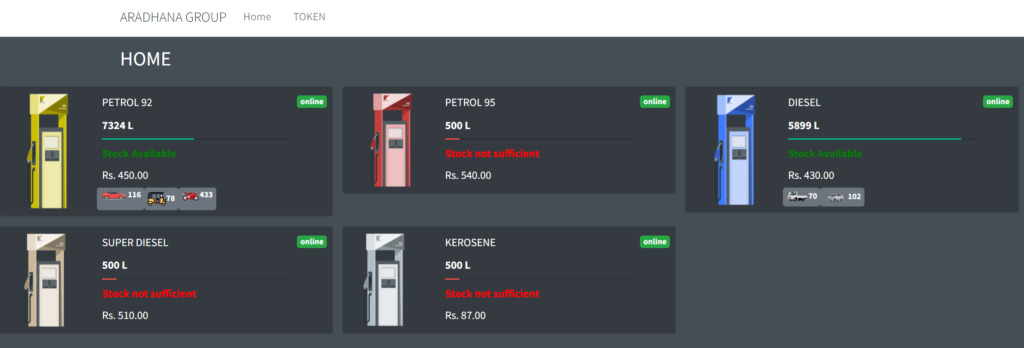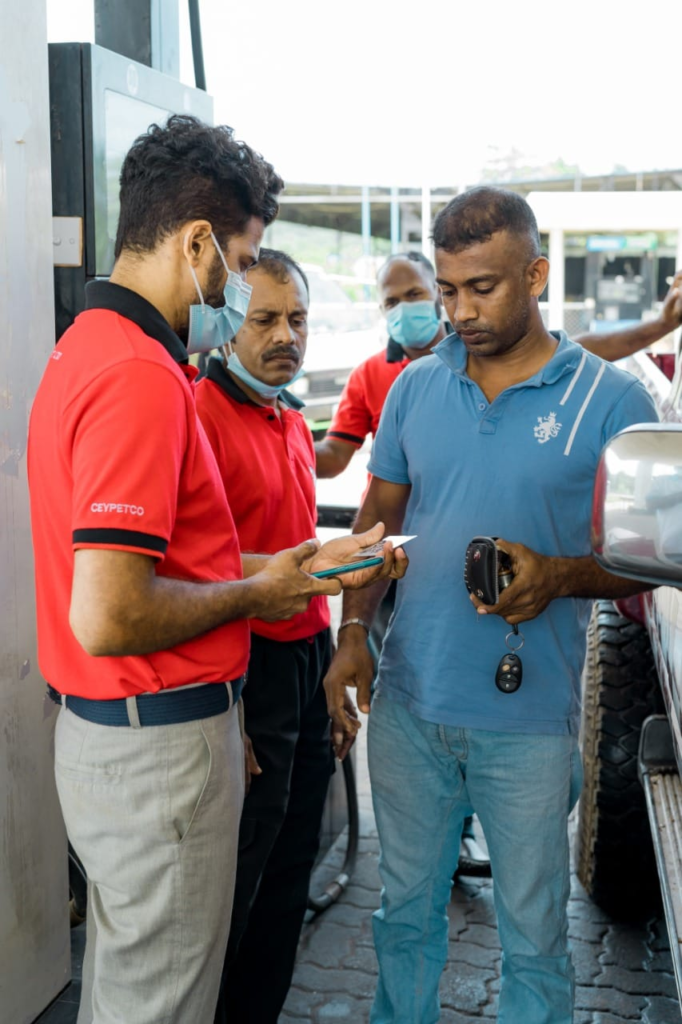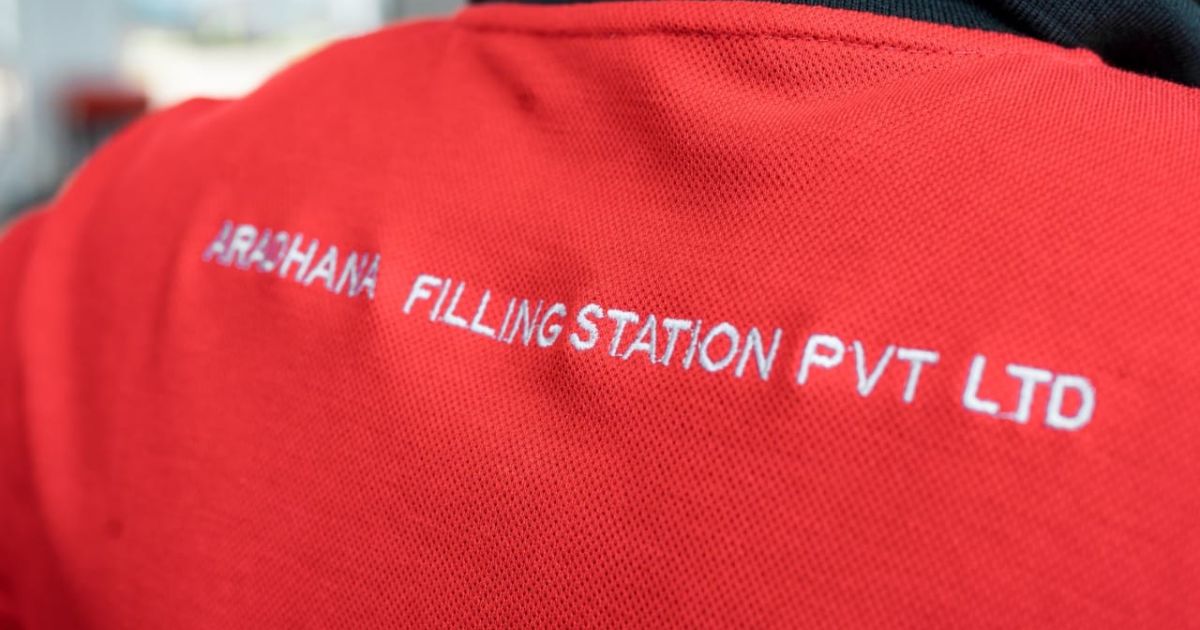The worst economic crisis in Sri Lanka since Independence began this year, with the country coming to a halt on multiple fronts as the Government struggled to provide even the basic necessities for the continuation of daily life. Amongst these shortages of necessities, the fuel shortage hit the hardest as severely depleted forex levels mean that the Government continues to struggle to find the almost USD 600 million needed to import fuel every month into the country. Until the introduction of the QR code system, which allows customers to obtain a weekly quota of fuel, lengthy queues, stretching for kilometres, were seen at almost every fuel shed in the country.
One fuel shed – the ‘Aradhana’ shed in Galle lived up to its Sinhala namesake, and created a more welcoming environment for the customers who had to otherwise endure multiple meals and sleeps in a fuel queue.
The Aradhana solution
Aradhana introduced a live webpage that shows its customers the amount of fuel available at the shed at any given moment which allows them to make a more informed choice about whether to make the trip to the shed at a time when fuel is scarce. This technology-based solution was developed by Cloud Arm – a company based in Galle and led by its Chief Executive Officer (CEO) Eranda Palliyaguru.
“I am the owner of a third-party company called Cloud Arm. I saw an opportunity at the shed because there was a queue but they seemed to handle it a bit differently than the other sheds. That is why I forwarded a proposal to them about what kind of things they can implement there to help the customers,” Eranda told us, explaining the motive behind their work.
Aradhana maintained an informative Facebook page from the first few weeks of the fuel crisis, which shows customers how much fuel the shed had received on a particular date.
Cloud Arm had first introduced a token system at Aradhana – “we just wanted to let people go home instead of waiting overnight at the queue outside the shed.”
However, this was introduced at an extremely difficult point for the customers, when there was almost no hope of obtaining even a few litres of fuel from sheds. At the end of June, before former President Gotabaya Rajapaksa was ousted, there was little over 5, 000 MT of petrol with the Ceylon Petroleum Corporation (CPC). Power and Energy Minister Kanchana Wijesekera, on 27 June, requested consumers waiting at fuel sheds to go home, adding that those already in the queue will be issued a token to use when fuel arrives in the country. The next day, the Government announced that CPC will only issue fuel to essential services, leading to confusion over the token system, and prompting the Government to clarify that tokens will not be given to those who joined the queue after 27 June.
“We first introduced our own token system at Aradhana. Since there was news from the government later that said not to issue tokens, we halted it. That system is still in the pipeline and can be revived to ease the burden on customers if necessary,” said Eranda.
One webpage later
Following the halted implementation of the token system, Eranda said that Cloud Arm saw a gap in the service provided by the Aradhana Facebook page.
“After they post about the stocks they receive on any given day, there is no way for customers to get updates. The platform was developed due to the request of the customers. Their main complaint on the Facebook page was that they could not see the live updates of stocks at the shed. That is why we went to the next step. So, we introduced the active webpage to show the live updates.”

Eranda says the response has been largely positive to the webpage, with about 99% of the customers appreciating this prior knowledge before they make it to the shed. Cloud Arm’s aim had been to make the technological solution “as basic as possible,” so that as many customers as possible are able to access it. They had targeted customers who can use a smartphone and navigate their Facebook page.
Aradhana’s webpage sees huge traffic on the days that they pump fuel.
“During the normal time, every 30 minutes, we get about 800 to 900 customers to the website. But once the shed starts issuing fuel, every 30 minutes, we get about 1,000 to 2,000 customers. If there is large traffic on Facebook, where the post is shared a lot, we get about 3, 000 to 4,000 views even.”
The need for transparency
The serious fuel shortage in the country has led to a thriving black market, with a litre of petrol being sold at about Rs. 3,000 in Colombo. The black market, while being a testimony to the difficulty experienced by the public due to the shortage, also indicates the need for greater transparency and accountability processes from suppliers about the stocks available with them.
Eranda said that when Cloud Arm had attempted to approach other fuel sheds with the same technological solution they had offered to Aradhana, the response had not been great.
“We do not know why the others rejected us. As a technology company, we can only develop these platforms. We tried with other fuel sheds but the biggest barrier was that some fuel sheds did not want to be transparent with the common people. Secondly, they did not want to spend the initial cost as they explained that they are running at a loss these days. If somebody wants to have a similar platform, we can develop and give – we tried for over a month to give to other sheds too.”
According to Cloud Arm, costs for the fuel shed lie in the domain which displays the data and the initial setup fee. While the Aradhanagroup.lk domain displays the data, Cloud Arm’s servers process the data. The cost is about Rs. 10, 000 per month for a fuel shed and there is a separate setup fee which depends on where the fuel shed is located as Cloud Arm is based in Galle.
Closing the gap with technology
Before the QR code system was implemented by the Government this month, the arrival of fuel at any given shed led to panicked activity outside the shed. Citizen-run Facebook groups would update the public on where fuel could be found, and which shed was pumping at a particular time. WhatsApp groups and Twitter accounts would talk about the length of the queue outside a shed, which allowed customers to make a choice about whether to join the queue or not.

In addition to the lack of fuel in the country, it was survival of the fittest, as the public fought with each other to get their hands on even five litres of fuel. The main problem remained the lack of transparency about where the Ceylon Petroleum Corporation (CPC) was sending its stocks and how the public could access that information.
Eranda said that a 100% solution to this issue can be provided with technology.
“If sheds do not want to invest in a domain, we can even display their data on the ‘Helakuru’ app. This should be a choice made by fuel sheds. From the government side, while the QR code offers some solution, if data is made available from the CPC, the process could be much faster, where even alerts can be sent to customers when fuel arrives at the sheds,” said Eranda.
Explaining the process of getting the data from the shed, Eranda said that there is a nozzle in every pump and data can be read from nozzle to nozzle through sensors.
“We take that data and push it to our server which processes it to show the status on the webpage. This is a fully automated system and there is no human hand involved in it. The QR code can be used to eliminate the need to attach sensors at every nozzle too,” he added.
Looking ahead
The fuel crisis did not hit overnight. Since 2021, Sri Lanka saw several Cabinet Ministers handling the subject areas of power and energy. Former Energy Minister Udaya Gammanpila first raised alarm bells at the beginning of 2022, when he expressed that the CPC was finding it difficult to find foreign exchange to purchase fuel. Gamini Lokuge followed Gammanpila, and under him, power cuts exceeded almost 13 hours per day as the Ceylon Electricity Board (CEB) could not source the necessary fuel for its thermal power stations from the CPC. Current Power and Energy Minister Kanchana Wijesekera was first appointed during the previous administration, under President Rajapaksa.
The QR system was implemented on 01 August, after seven months passed into the year, and after the public spent many sleepless weeks in fuel queues. While there seems to be no immediate solution to the fuel shortage in the country, the weekly fuel quota adds a level of convenience to people’s lives, as they battle crises on multiple fronts due to the economic fallout of the country. When sheds such as Aradhana implemented simple technological measures in a transparent manner to help their customers, the question remains as to why other sheds could not follow suit during this difficult time. The larger question continues to be directed at the institutions and at the governing members as to why they did not plan ahead for this crisis and propose these solutions at the right time.







GIPHY App Key not set. Please check settings